What Do Clams Eat?
Clams are filter-feeders. Ocean clams feed at high tide, when the sand in which they are buried is covered by water. At low tide, clams wait for the water to return. Freshwater clams feed all the time.
Clams extend their siphons or “necks” to take in water for oxygen and food. They exhale the water through the siphon after respiration and removal of nutritious particulates (ingestion). “Food” to a clam is the suspended particles present in the water of its habitat. Much of this mass is made up of plankton, ubiquitous at the very top level of ocean water and otherwise circulated through all but the deepest (intercontinental) sea levels. For clams to eat, the water available to them must be in motion.
Clams respirate through the movement of water across their gills, although some O2 intake takes place along the body mantle. Water is propelled across the gills and the body proper by means of cilia, tiny hairlike protrusions of protein. O2 intake is low, and estimated at under ten percent of that present in the amount of total water processed.
What constitutes the biomass clams consume? Whatever is floating nearby. Clams are indiscriminate feeders. Suspended particles may include products of decomposition from dead sea animals, plant protozoans, tiny pieces of seaweed and so on but it is microorganisms plants need to build their bodies, which are almost 100% protein. Saltwater clams are not fed when cultivated, and gather their nutrition from particles common to the area in which they are berthed. Freshwater clams, as in a private tank, need not be fed at all should other sea animals be present: they will take in particles of fish food along with fish excrement and flaked-off skin cells. Should the freshwater clams exist in isolation, cultivated “green water” available at pet shops, along with dried seaweed containing spirulina is good nutrition.
Not all substances taken in by clams are healthful to humans. Common contaminants are the consequence of runoff from nearby streets and homes into the clam beds. This runoff may contain petroleum distillates, heavy metals, antifreeze, pesticides and other dangerous chemicals. Heavy metals such as chromium will build up in a clam’s flesh over time without killing it, leaving it dangerous for human consumption. More often, seasonal microorganism blooms make clams unsafe to eat. Dynoflagetllates, a type of single-celled photosynthetic animal are a natural part of the plankton food chain. They are characterized by two flagella, whiplike “tails” that permit limited locomotion. Dynoflagellates are indigenous to the Atlantic and Pacific coasts of the United States. They become hazardous only at times of “red tide,” coherent blooms which are monitored each year by oceanographers. Should red tide infest clamming grounds, the animals are no longer safe to harvest or eat. This is because red tide dynoflagellates secrete a type of neurotoxin known as cegrotoxins. These interfere with the movement of sodium ions (Na+) across human cell membranes thus impairing nerve and muscle communication. In rare instances, red tide infection results in paralytic shellfish poisoning (PSP). The condition is curable with prompt treatment, but left untreated can result in breathing problems and eventually death by asphyxiation.
Dynoflagellates are also known as the source of “cold light,” bioluminescence sometimes observed by nighttime swimmers. This photo effect results when the luciferin in dynoflagellates is broken down by luciferase in the presence of oxygen and adeninotriphosphate (ATP), and the dynoflagellate is disturbed by nearby motion. To the swimmer, faint illumination, with a green, yellow or bluish cast follows arm and leg motion through the water.
Non-fatal poisoning from contaminated clams is not unusual in the US, particularly in summer months. Fortunately, most clam-borne illness is caused by clams that have ingested septic runoff. Eating such a clam is likely to produce a one to two-day bout with chills, violent nausea and fever, but the condition is not life-threatening except to those with impaired immune systems. Red tide poisoning can be fatal. If you have any doubts about illness caused by eating bad clams, take the patient to the hospital immediately. Clamming beds are tested each year by local governments, generally at the town level per county rules. Red tide blooms are closely tracked by organizations such as the Woods Hole (Massachusetts) and Scrippts (California) Oceanographic Institutes. When a red tide bloom approaches shore, warnings are posted by law. Some red tide blooms never present a danger to humans, because they stay out at sea. In recent years, red tide blooms beginning in the Gulf of Maine and spreading south and west have become more of a concern. Whether this is due to an increase in atmospheric CO2 over time (“global warming”) is not yet known.
Copyright © 2011-2015 Clam Hooting Skipper John and Ted Escapes | Privacy Policy | Earnings Disclaimer | About Us | Contact Us
How to Take Care of a Live Clam
wikiHow is a “wiki,” similar to Wikipedia, which means that many of our articles are co-written by multiple authors. To create this article, 26 people, some anonymous, worked to edit and improve it over time.
wikiHow marks an article as reader-approved once it receives enough positive feedback. This article received 19 testimonials and 84% of readers who voted found it helpful, earning it our reader-approved status.
This article has been viewed 173,404 times.
Clams are a wonderful, low-maintenance addition to any tank, as they naturally filter out some microorganisms and make beautiful, decorative structures on the bottom of your aquarium. However, just because they are low maintenance doesn’t mean that they don’t require any work at all. With a little knowledge, you can easily make clams a part of your next aquatic ecosystem.
Clam Care Explained: What Do Clams Eat? What Should You Feed Them?
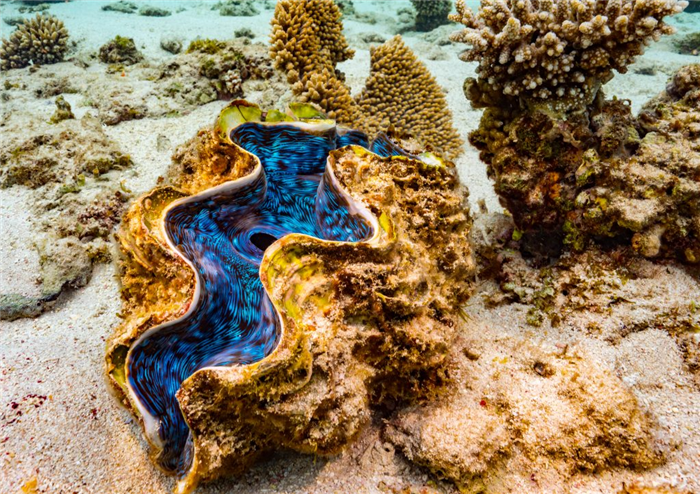
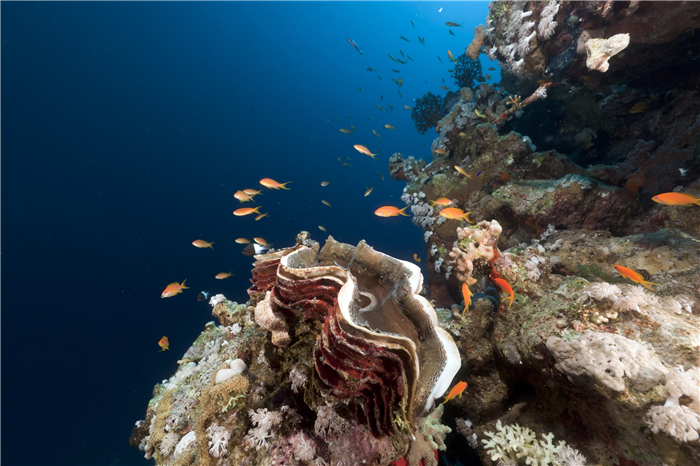
Show all photos 1
Published on Oct 13, 2021
Get inspiration for education!
Subscribe for virtual tools, STEM-inspired play, creative tips and more
A clam is a marine animal that eats by straining food from water, sand, or mud with its two shells.
Clams are a kind of shellfish. Clams may be found in both saltwater and freshwater habitats.
A fish is a vertebrate. Any member of the invertebrate class Bivalvia are mollusks with two shells present. This mollusk’s shell is made up of two hinged sections called valves. Bivalves are found in all seas and number more than 15,000 species. About 500 species of clams dwell in freshwater. They are often found on muddy or sandy substrates. Clam digging is a term used in North America to describe a common technique used to harvest clams beneath the surface of tidal sand or mudflats.
Gigantic clams range in size from 0.04 in (0.1 cm) in Condylocardia to 9.6 in (24.4 cm) in the Pacific and Indian shore. The clam fish contains two powerful lateral muscles known as ‘adductor muscles’ that allow it to close completely.
The majority of clams live in shallow waters, where the surrounding bottom protects them from wave movement. Clams take in and expel water through two tubes, the siphons, or ‘neck’ in the body for breathing and feeding. The water is pushed by the beating of millions of cilia (hairlike structures) on the gills. Other gill cilia strain food from the incurrent water and carry it to the mouth, entangled in mucus. The female generally sheds her eggs in the water, where they are fertilized by sperm produced by the male. The eggs hatch into larvae that swim for a short time before settling permanently on the ocean shore.
Razor clams belong to the Solenidae superfamily in the marine bivalve animals. Pacific razor clams live on a sandy beach with the tide down to around 6.04 ft (1.8 m) of sea depth. Razor shells are a term used in England to describe species of the genera Ensis and Solen. Intertidal sands and muds, especially in temperate waters, are abundant in Solenidae. Shells of razor clams bivalves measure up to 9.6 in (24.4 cm) in length and are thin and elongated. They consume particle matter in saltwater using their small siphons. By jetting water via the siphons, certain species are able to swim over short distances.
The softshell clam is soft edible with a thin, elongated shell. Because of their delicate shells, they’re known as ‘soft’ shell clams. In the middle Chesapeake Bay, a clam lives covered in soft soils. Softshell clams use a single tube to pull in water and subsequently filter out plankton. The opposite siphon frees the remaining water and particles. It may be found in all oceans, burrowing into the mud to depths of 0.3-1 ft (0.1-0.3 m). The shell is a dirty white oval shell with a length of 3-7.8 in (7.6-19.8 cm).
If you like this article, you may also enjoy what do seahorses eat and what do koi fish eat on Kidadl.
What do clams eat in the ocean?
Clams are voracious eaters. Suspended particles slightly tend to contain decomposition products from dead marine tiny creatures, plant protozoans, small bits of seaweed, and other microbes, but it is microorganisms that plants use to create their bodies, which are nearly entirely made of protein. A clam’s food is the suspended particles in its environment’s water. Freshwater clam care may be as easy as laying the clam upright on the substrate in the appropriate settings and under ideal conditions.
At high tide, when the sand in which they are buried is submerged by water, ocean clams feed. To dig into the sand, the clam’s foot is present. Clams wait for the water to return at low tide. Freshwater clams are always hungry.
Giant clams of the genus Tridacna are the biggest extant bivalve mollusks. The gigantic clam may be found at depths of up to 13.4 ft (4.1 m) in flat coral sand or broken coral. They may be found off the coasts of the Philippines and on the coral reefs of Sabah in the South China Sea. A giant clam filters particulate food, including minute sea plants (phytoplankton) and animals using its siphon. The bulk of its nutrients, on the other hand, are acquired through a mutually beneficial interaction with the billions of algae that reside in its tissues.
Algae produces proteins and carbohydrates which are consumed by giant clams to help them grow to huge sizes. Algae that grows on a gigantic clam’s tissues create carbohydrates and proteins, which the clam consumes. Giant clams and the zooxanthellae (algae) that reside in their tissues share a symbiotic connection.
Clams breathe by moving water across their gills, while they can take in oxygen through their body mantle. Cilia, microscopic hairlike protein protrusions, move water through the gills and the organism as a whole. The amount of oxygen consumed is modest and is believed to be less than 10% of the entire amount of water treated.
How do clams eat?
The uncertainty caused by the rearrangement of feeding is likely to result in less frequent feeding. The incurrent tube allows water-containing food material to enter.
Following that, the water flows through their gills. The water comes into contact with a glue-like mucus which traps the tiny food particles. Clams’ mouths process the trapped food and is subsequently transferred through the cilia, labial palps, and mouths. The exhalant tube removes the water that has passed through the clam’s gills.
Clams’ siphons extend to take in water for oxygen and food. After respiration and elimination of nutritional particles, they exhale the water through the siphon (ingestion). Plankton, which is abundant at the very top level of ocean water and otherwise cycled through all but the deepest (intercontinental) sea levels makes up a large portion of this mass. The water available to clams must be moving in order for them to eat.
What do freshwater clams eat?
Freshwater clams eat small particles of floating edible materials in the water column and are filter feeders. This floating food can come from both natural sources and supplements. Freshwater clams will eat fish food particles as well as fish poop.
Freshwater clams may be found in a variety of environments, including lakes, canals, rivers, and swamps, and flourish in established local aquariums. Freshwater clams are non-aggressive filter feeders that are friendly. Their filter-feeding aids in the removal of particles from the tank’s water. Shells of freshwater clams range in size from 1-2 in (2.5-5.1 cm) in diameter.
Freshwater clams consume uneaten food and debris, which helps to keep the tank water to stay clean. Freshwater clam care may be as simple as placing the clam upright on the sediment in the proper places and under the right circumstances. If the environment and habitat are not adequate to satisfy their demands, freshwater clams do not live very long.
Freshwater clams require at least a 20 gal (91 l) aquarium to be properly cared for. Because freshwater clams tend to burrow and conceal themselves, they require a medium to extremely fine substrate. Only a little portion of the shell can be seen at times. Freshwater clams spend much of their time on the tank’s bottom relaxing. As a result, ensure the substrate is fine and deep enough for the clam to burrow.
Freshwater clams prefer aquariums that aren’t overly spotless. The water in an aquarium should have a lot of very small debris, detritus, and decaying matter floating around in it. This isn’t to say that the tank can’t be aesthetically pleasing, but it does mean that the aquarium water must have enough edible stuff for the clam to consume.
The life of freshwater clams is six months or more. It’s critical to remove the freshwater clam from the aquarium straight away if you suspect it’s dead. With a net, gently take the clam out from the tank for inspection.
The blood of most clams is transparent, however, the blood of a clam includes hemoglobin which might lead to human blood illnesses e.g. typhoid. Clams are available in a wide range of sizes and forms depending on feeding habits and environment.
What do you feed a clam?
Your clams can consume a lot of the leftover food from the rest of the tank, but they will need some extra food to flourish, especially in newer aquariums with fewer creatures.
Younger clams are more active and will eat often to encourage development. Furthermore, a clam’s diet tends to alter as it matures. Feed your clams once or twice a week to supplement their natural diet. Clams are filter feeders that will feed on phytoplankton and zooplankton in the water. They get their healthy diet from the algae, and the algae get a safe place to live and flourish. Their death rates are greater as a result of their rearrangement of eating patterns as they metamorphose.
Here at Kidadl, we have carefully created lots of interesting family-friendly facts for everyone to enjoy! If you liked our suggestions for what do clams eat then why not take a look at what do shrimp eat or clam facts.
Written By
The Kidadl Team is made up of people from different walks of life, from different families and backgrounds, each with unique experiences and nuggets of wisdom to share with you. From lino cutting to surfing to children’s mental health, their hobbies and interests range far and wide. They are passionate about turning your everyday moments into memories and bringing you inspiring ideas to have fun with your family.
Read The Disclaimer
Disclaimer
At Kidadl we pride ourselves on offering families original ideas to make the most of time spent together at home or out and about, wherever you are in the world. We strive to recommend the very best things that are suggested by our community and are things we would do ourselves – our aim is to be the trusted friend to parents.
We try our very best, but cannot guarantee perfection. We will always aim to give you accurate information at the date of publication – however, information does change, so it’s important you do your own research, double-check and make the decision that is right for your family.
Kidadl provides inspiration to entertain and educate your children. We recognise that not all activities and ideas are appropriate and suitable for all children and families or in all circumstances. Our recommended activities are based on age but these are a guide. We recommend that these ideas are used as inspiration, that ideas are undertaken with appropriate adult supervision, and that each adult uses their own discretion and knowledge of their children to consider the safety and suitability.
Kidadl cannot accept liability for the execution of these ideas, and parental supervision is advised at all times, as safety is paramount. Anyone using the information provided by Kidadl does so at their own risk and we can not accept liability if things go wrong.
Sponsorship & Advertising Policy
Kidadl is independent and to make our service free to you the reader we are supported by advertising.
We hope you love our recommendations for products and services! What we suggest is selected independently by the Kidadl team. If you purchase using the buy now button we may earn a small commission. This does not influence our choices. Please note: prices are correct and items are available at the time the article was published.
Kidadl has a number of affiliate partners that we work with including Amazon. Please note that Kidadl is a participant in the Amazon Services LLC Associates Program, an affiliate advertising program designed to provide a means for sites to earn advertising fees by advertising and linking to amazon.
We also link to other websites, but are not responsible for their content.
What Do Clams Eat? The 5 Foods They Consume
Clams are bivalve mollusks that generally thrive in freshwater and saltwater settings. Although they resemble other mollusks like oysters and mussels, clams have some unique characteristics that make them worth examining. For example, their means of locomotion, a “foot”, along with their feeding methods are just two interesting facets of clams. Looking at these creatures, it can be hard to imagine that they eat at all, so let’s answer the question, what do clams eat?
Discover what foods they prefer, how they process a meal, and what creatures are trying to eat them, too!
What Foods Do Clams Eat?
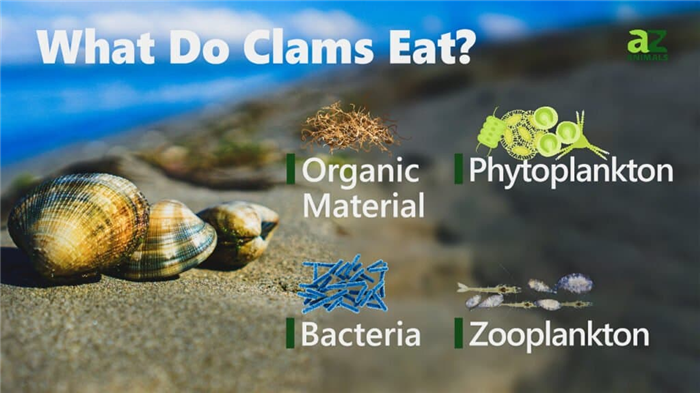
Clams eat plankton, algae, and other organic matter.
Clams eat algae, zooplankton, phytoplankton, and other organic matter that passes through their filtration system. These mollusks are omnivores that eat both plants and animals, albeit in their smallest forms. These bivalves do not have a voracious appetite, but they eat all the following:
- Algae
- Byproducts from symbiotic algae
- Zooplankton
- Phytoplankton
- Organic matter flowing in their aquatic habitats
Although these broad categories of foods might make it seem like clams do not eat a lot of food, the truth is that the clam’s diet has serious variety in it. As filter feeders, clams will eat anything with nutritional value that comes through their siphons.
That could be organic matter from decaying plant life or even excrement from aquatic creatures. In that sense, the clam’s diet can be very diverse under the umbrella of these five types of food.
How Do Clams Eat Their Food?
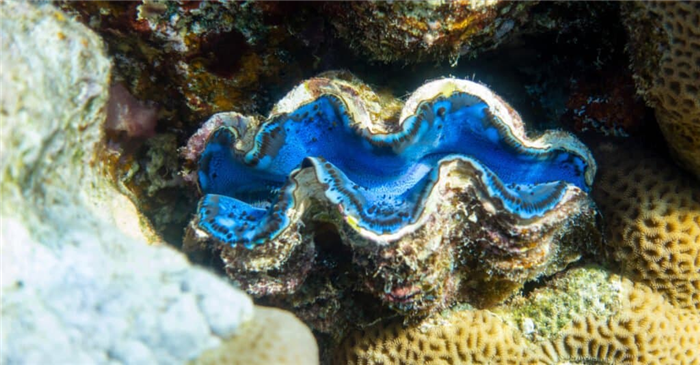
Clams filter-feed to obtain food and also form symbiotic relationships.
Clams use very intriguing methods to obtain and consume their foods. For one thing, clams can move a little bit with the help of a “foot.” They use this conical muscle to better position themselves in water to obtain nutrition. They do not bind themselves to a substrate like oysters; they’ll find an area rich with food, and burrow enough to stay put while they feed.
Clams obtain their food by filtering water through an intake siphon and an exhalation siphon in their bodies. Food passing through their gills is trapped in a sticky mucus that moves through cilial action to the labial palps and later to the clam’s mouth. Plankton, algae, and organic matter are consumed this way.
Clams also have another method for obtaining nutrition, too. Some species of clams develop a symbiotic relationship with algae, such as zooxanthellae. These algae live in the mantle of the clams. While the mollusk takes in and feeds the algae the nitrogen it needs to thrive, the algae provide the clam with various nutrients.
All told, clams can process about 24 gallons of water each day in search of food.
What Do Clams Eat in Winter?
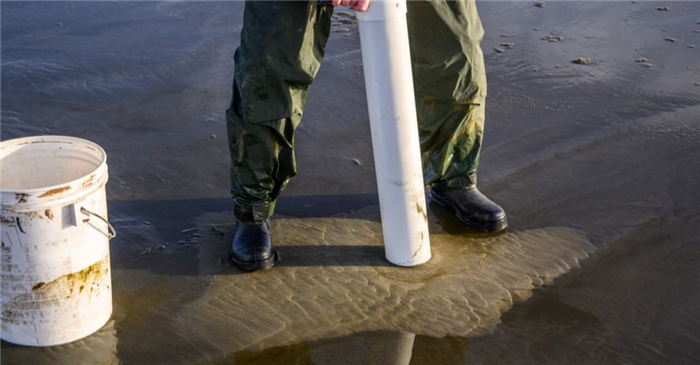
Clams bury themselves and go dormant in winter, but they can be harvested during this time.
The clam’s “foot” helps the creature move around to more habitable areas or find safety by burrowing into the sand. Typically, they will only dig down into the sand or mud enough to keep themselves safe from predators but not too deep that their siphon can’t bring in nutrient-rich water.
During the winter, clams use this muscle to dig an extra-deep hole for themselves. This burrow is slightly deeper than their siphons are long, effectively burying them for the duration of the winter season. The clams go dormant for the season, beginning when the temperature dips below freezing.
In other words, clams eat very little, if anything, during the winter as they are too busy trying to survive the cold that accompanies the season.
What Impact Does the Clam’s Diet Have on Others?
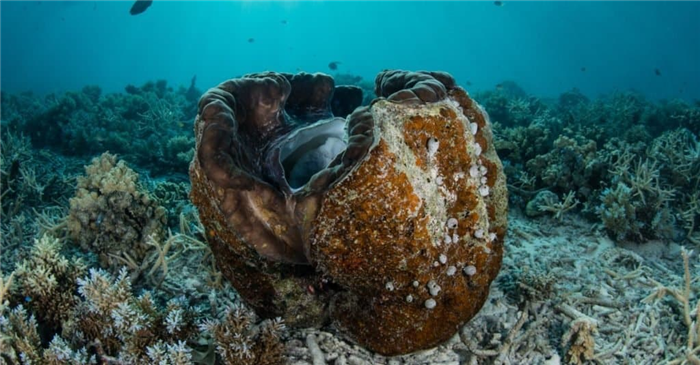
Large clams help remove excess nutrients from waterways, improving the environment.
Clams’ filter-feeding methods have a significant impact on the bodies of water that they inhabit. Specifically, they can help prevent eutrophication, the process by which excess nutrients in bodies of water leads to suffocating algae blooms, increased phytoplankton levels, and low oxygen levels.
Eutrophication can cause mass fish deaths and create cascading damage to the ecosystem. Fortunately, clams and other mollusks, like oysters, help remove a lot of the excess nutrients through their filter-feeding. The symbiotic relationship between clams and zooxanthellae is even more beneficial in this light, removing nitrogen from the environment while also creating food for itself.
A large clam can filter up to 24 gallons of water each day, so areas with thousands of clams can remove quite a bit of nitrogen and phosphorous from a body of water throughout the course of a year. That results in cleaner waterways and a thriving ecological system.
All told, the foods consumed by clams have a significant and measurable impact on the environment, and this effect might be purposely utilized in the future to repair waterways.
What Predators Eat Clams?
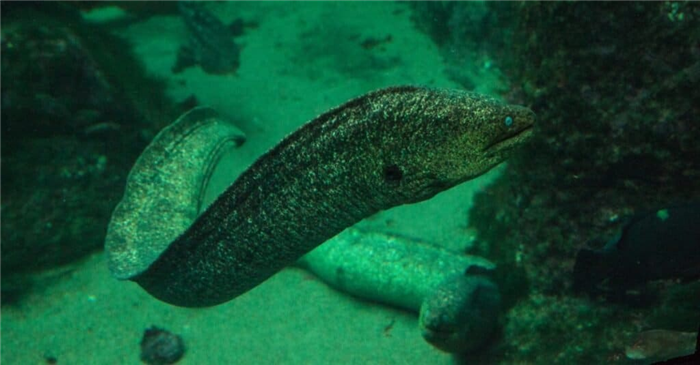
Eels can crack a clam’s shell and eat the mollusk within.
Clams are invertebrates with soft bodies wrapped in a hard shell. Unfortunately for them, their shell and the ability to bury themselves in sand and mud are the only means of protection available to them. These creatures are very easy to prey upon, and many animals throughout the world take advantage of the clam’s helplessness.
Even though they have a rudimentary foot protrusion, it is not enough to help them escape predators even when they are buried.
The most common clam predators include:
Each of these creatures can pry open the shell or otherwise get to the clam’s soft body. Human beings are the most dangerous of all to the clams because they frequently catch and eat clams as part of their diet or kill them and keep their shells for decoration.
Clams are somewhat unfortunate in the sense that they lack a way to fight back against predators or detect them in time to close their shells all that often. Their environment does help to a degree, though. Fortunately, most common clams are not endangered.
Clams might not be exciting creatures at first glance, but they have many interesting facets. Their contributions to the environment, symbiotic relationships with algae, and the mere presence of their “foot” make clams worth looking at with a sense of intrigue. The clam’s diet is not particularly exciting, but it is diverse and helps keep their waterways clean.
Share this post on:
Kyle Glatz
I’m a freelance writer with 8 years of experience. I’ve written in a variety of niches such as video games, animals, and managed service providers. I graduated from Rowan University in 2014 with degrees in English and Education. When I’m not working, I enjoy playing video games, reading, and writing for fun.
Diet of the Giant Clam
Giant clams grow to their enormous size by eating the sugars and proteins created by the billions of symbiotic algae that live inside their tissues.
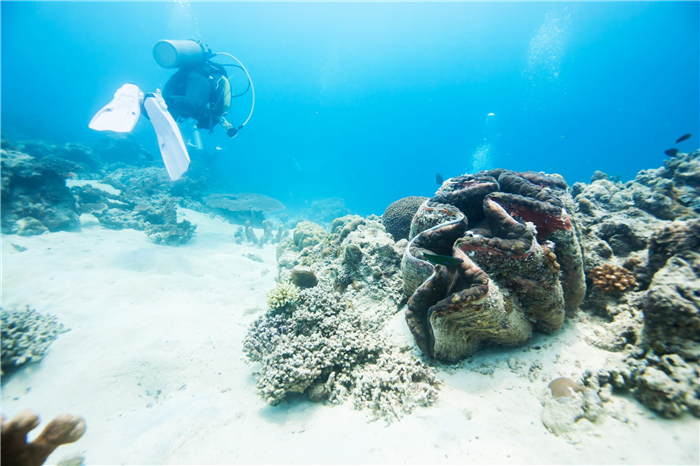
A clam’s multicolored shell is wildly colorful thanks to the many algae forms (also called zooxanthellae) that grow within its body.
Thanks to their intimate relationship with plant-like algae, giant clams can live up to 100 years and beyond.
The giant clam provides a safe home and regular exposure to sunlight for the algae. The algae grow via photosynthesis (using sunlight to convert carbon dioxide into food or energy) during the day when the giant clam’s fluted shell opens and exposes its vibrantly colored mantles.
